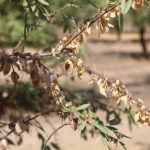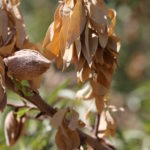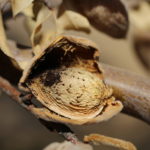
Written By Brent Holtz, Ph.D., UCCE Farm Advisor San Joaquin County
In September I visited an almond orchard in San Joaquin County with the Supareil variety showing symptoms that looked very similar to hull rot typically observed on Nonpareil. Symptoms showed dieback of vigorous young shoots and lower limbs (photo 1-blighted shoots). Leaves were stuck on many shoots and typically blighted while hulls were unusually shriveled (photo 2-shriveled hulls), with fungal sporulation observed on the inner hull next to the shell (photo 3-fungal sporulation). The fungal sporulation, however, didn’t look similar to the sporulation typically observed on hulls infected with Rhizopus stolonifer or Monilina fructicola, the typical pathogens associated with hull rot of almond. Many of the larger blighted shoots seemed to still be alive even though they had defoliated, while other blighted shoots were starting to push new leaves in September—not typical of blighted shoots infected with Rhizopus or Monilinia.

Samples of infected hulls were sent to Dr. Themis Michailides, a plant pathologist with UC Davis / Kearney Research and Extension Center, where he isolated Aspergillus niger from 88% of the samples collected. The other 12% of the diseased nuts collected were found to be infected with Rhizopus stolonifer, the typical bread mold pathogen commonly associated with hull rot. Aspergillus niger has not commonly been associated with hull rot in the San Joaquin Valley, but Dr. Mohammad Yaghmour, Farm Advisor in Kern County, has also observed similar hull rot.
Hull rot can reduce yields of vigorous young almond orchards in the central and southern San Joaquin Valley. Symptoms often observed are dieback in lower limbs that often exhibit less bloom in the spring. I’m wondering how the Supareil return bloom will be in this particular orchard next spring? I believe severe hull rot can enhance the shading out of lower limbs as the tree abandons infected wood in the lower canopy for healthy wood receiving sunlight at the top of the tree. The loss of fruiting wood can negatively affect yield. Vigorous, heavily-cropped, five-to-ten year old, well-watered and fertilized orchards typically suffer the most damage. Irrigation management has been shown to reduce hull rot, caused by Rhizopus and Monilina, by implementing mild water stress on trees during early hull split. Mild water stress does not negatively impact long term

productivity and may even reduce unwanted vegetative growth in mature canopied orchards, but we don’t know yet if mild water stress will reduce hull rot associated with Aspergillus niger. Hopefully Dr. Yaghmore’s studies in Kern County will help us determine what control measures will be the most successful against Aspergillus induced hull rot. I have included a review of hull rot from The Almond Doctor https://thealmonddoctor.com/2009/06/30/hull-split-part-2-hull-rot-of-almond/

